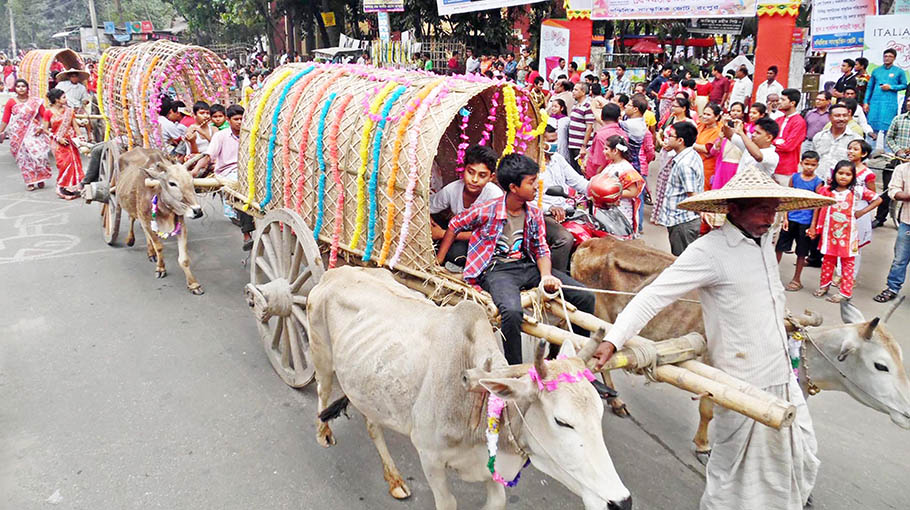Chaitra Sankranti celebrated in Rangpur

People in the rural areas of Rangpur still follow the old fashioned way on the first day of Boishakh. Though there is a touch of modernity everywhere now, people in this region still cherish that tradition. The last day of the Bengali year is called ‘Chaitra Sankranti.’ According to the tradition, bathing, alms, vows, fasting are considered as good deeds on this day. Around ‘Chaitra Sankranti’, the monks dance to the beat of musical instruments and walk around with a portrait of the goddess (jute) on their head. The housewifves of the houses welcomes them and offer them to sit in traditional chair. Then they put the jute on the pedestal or water post. At the time, the monks dance and sing songs for the welfare of the household. At the end of the song, the housewives give rice, vegetables or money to the monks. ‘Chaitra Sankranti’ festival and Charak Mela were organized to spread the culture of Bengal to the new generation with the collected money.
According to the old tradition, the people of the rural areas of Rangpur eat Tita Jati (juice of lower leaves, juice of neem leaves, juice of indigo) in the morning of ‘Chaitra Sankranti’. They believe that there will be no disease in the body throughout the year. Besides, khesari, lentils and gram are mainly chewed and eaten. The main thing is to strengthen the teeth. Today, on the Pohela Boishakh, good food, wearing good clothes, not to quarrel, not to deal with anyone, including the preparation of the various rules have been taken. In this way the people of Rangpur region follow these old customs on the first day of Boishakh.
It can be seen that preparations are going on in Rangpur for the Pohela Boishakh. The people of Rangpur are going to celebrate the Bengali New Year after two years due to worldwide pandemic Covid-19. In the New Year, there are Boishakhi processions, various competitions, and traditional cultural programmes of rural Bengal. The Boishakhi procession will leave the town hall premises at 10 am organized by the district administration. Later, the procession will end at Boishakhi Battala of the district school ground. There will be cultural programmes after various competitions. Once again, preparations were going on at the Baishakhi Battala of Rangpur district school ground on Wednesday. The students were painting the tradition of rural Bengal with the help of paintbrushes. Some are making peacocks with bamboo and wood, some are busy drawing fishes. Again, some of the artisans are drawing watercolor pictures with deep attention, some are designing in the mud. Besides, the students were making flowers, owls and wings by cutting paper. Students were seen busy drawing on the walls and roads of the district school. Artist Turin said, ‘The Boishakh celebrations have been closed for the last two years due to Corona. However, this time the event has been made smaller as the first Boishakh is in Ramadan. However, it is a great pleasure for us to be able to celebrate the New Year after two years,”said Arnab, a student of the district school. This festival actually works a different thing in our minds. With that enthusiasm we are preparing to celebrate the Pohela Boishakh. Additional Deputy Commissioner (Education and ICT) of Rangpur AWM Raihan Shah said that the Pohela Boishakh has been taken by the district administration on the occasion of Bengali New Year. However, arrangements have been made ahead of Ramadan. Besides, various literary and cultural organizations of Rangpur including Begum Rokeya University administration have taken various programs to celebrate the New Year.
Nawab Murshid Quli Khan started the festival of 'Punyah' on the holy Boishakh. At that time, due to the development of some national capital, an improved condition of trade and commerce was being created. It was these traders who started the 'Halkhata' festival as an adjunct to Punyahar. The economy of Bengal was dependent on agriculture. As a result, the supply of cash to the farmers would come only at harvest time. So they were forced to buy the rest of the daily necessities from traders or shopkeepers. On the first day of the New Year, in the Halakhata festival, the names were written in the Halakhata or new khata by paying the arrears in full or in part. Of course, there were also instruments of joy in it. On the occasion of Halkhata, it was customary to eat and drink, especially to distribute sweets. Following that tradition, the traders of Rangpur region organize halakhata at home or in business establishments on the Pohela Boishakh. A variety of food items including monda-sweets were prepared at home to entertain the guests.
Organizing fairs in different areas of Rangpur on Chaitra Sankranti and Pohela Boishakh is a very old tradition. Mela/fair is one of the elements of traditional folk culture of Bengal. The fair once played an important role as a means of communication in rural life. A festive atmosphere is created around the fair. People from several nearby villages come to the fair. This interaction plays a positive role in creating social harmony. The main products of the Grameen Mela are the products and agricultural products produced by the local artisans. A large collection of bamboo, cane, jute, shola, metal, clay, leather, fibrous assorted handicrafts and children's toys make the rural fair colorful. Along with this there is a collection of Khwaja, Gaja, Mawa. There are various arrangements including merry-go-rounds, puppet dances, ghazi songs, jatrapalas, circuses, lathikhelas. But in the last two years, this festival of the life of Bengalis has had to be called 'Nna' out of fear. Still sitting at home, people are celebrating the first Baishakh of the Bengali New Year following the tradition of the old days, praying that the Pohela Boishakh brings a message of happiness in everyone's life.




